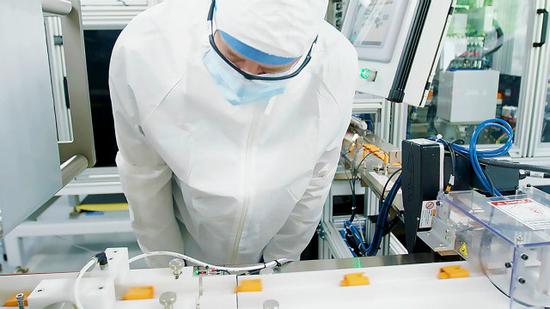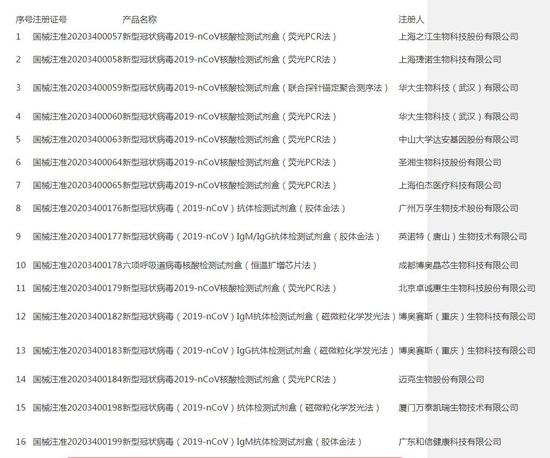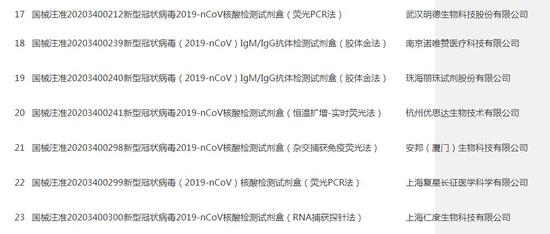Looking at the detection of new coronavirus, these key issue
Release time:2020-04-14 19:19:34Views:
Original title: Perspective of the new crown virus detection, these key issues can not be ignored
The developed detection reagents are actually divided into three categories, namely nucleic acid, antibody and antigen detection.
Since the full gene sequence of the new coronavirus was released on January 11, 2020, various virus detection methods and equipment have developed rapidly. At present, there seem to be many detection reagents available on the market, some of which are simple detection methods aimed at the public.
However, during the interview, the First Financial Reporter learned that the detection reagents that have been developed are actually divided into three categories, namely nucleic acid, antibody, and antigen detection. What is the difference between them? What about accuracy? How do people in the industry view different detection methods?

It is understood that there are usually two strategies for detecting infectious diseases, one is to detect the pathogen itself, and the other is to detect antibodies produced by the human body in order to resist the pathogen. Pathogen detection can detect antigens as well as nucleic acids. Antibodies are a type of protein product produced by the human immune system against viruses, and are usually produced 1-2 weeks after infection. Therefore, if any one of nucleic acid, antibody or antigen is detected in the subject's body fluid, it means being infected.
Chen Jingxian, an expert in the subject of Golden Respiratory Diseases and an inspection team of the Golden Coronary Medicine New Coronavirus Pneumonia Epidemic Prevention and Control Group, said in an interview with the First Financial Reporter: "Viral nucleic acid is a component of a virus, so detection of nucleic acid means There are pathogens. It can be used for early diagnosis, as well as for the observation of the treatment effect during the course of disease and as an indicator of treatment discharge. The specificity and sensitivity of detecting nucleic acids are extremely high, because viral nucleic acids can be used in the laboratory for a short time. Internally selectively amplified by several million times and easily detected. "
This is why nucleic acid detection is still considered the "gold standard" for the detection of new coronaviruses. Chen Jingxian further said: "Because the new coronavirus is an emerging virus, we have no pre-existing antibodies to it, so when an antibody appears (whether it is IgM or IgG), it means that it has been infected. The antibody positive can be Patients, but it can also be asymptomatic infected persons, recessive infected persons, or convalescent patients and vaccinated patients. "
Pointed out to reporters that although antibody detection is simple and fast at the technical level, its specificity and sensitivity are usually lower than nucleic acid detection. This is because it is not easy to prepare a highly specific antigen. For example, the antigen used to detect new coronavirus should not only not cross-react with other bacteria and viruses common in the respiratory tract, but also have a close relationship with other coronaviruses, especially The recent SARS coronavirus and SARS-like bat coronavirus can be distinguished.
The reporter also noticed that after the human body was infected with the new crown, there was a difference in the time that nucleic acids and antibodies could be detected. According to theoretical data, nucleic acids can be detected 1-2 days after infection; IgM (antibody) can be detected in about 7-14 days; IgG (antibody) can be detected in about 21 days. And some patients with weak immune function may have a phenomenon of low antibody amount, which is easy to cause false negative problems in antibody detection. At the beginning of infection, the pathogen antigen content is also low, which is also not easy to detect. Therefore, antibody testing should not be used as a basis for eliminating infection.
With the continuous development of the epidemic situation, companies are scrambling in the field of detection, and the public's expectations for virus detection are also increasing. Should we see the new coronavirus detection correctly?
According to reporters, the current detection products of the new coronavirus are professional medical device products. Although the colloidal gold method is easy to operate and only requires blood collection testing, the use approved by the state also clearly stipulates that it can only be used by medical institutions and must be used by professional Medical professionals operate. The reason is that the collection of blood samples requires certain conditions, the test requires corresponding temperature and humidity, and the judgment of the results requires corresponding professional knowledge (especially in a critical state), there are certain risks in self-operation, and AIDS, hepatitis B, etc. will also be transmitted through the blood.
In addition, although some social platforms such as WeChat Moments and other social platforms have been selling self-test equipment, but the relevant regulations are clear, new coronavirus detection kits are managed according to the third category of medical devices, and must be sold by qualified and licensed companies , And these enterprises can not be sold to individuals, because the purpose approved by the state clearly stipulates that it can only be used by medical institutions.
Attachment 1: The characteristics of the different detection methods that have been approved (of which only the colloidal gold method does not need to be operated in the laboratory)
1. Fluorescence PCR method: detection of specific target genes of new coronavirus, usually completed in 2-3 hours; but it requires professional personnel in the laboratory to operate, and transportation requires cold chain.
2. Combined probe-anchored polymer sequencing method: whole genome sequence determination, the accuracy rate can reach 100%, but the cost is high, the operation is complicated, and it is not suitable for routine clinical detection. Usually 22 hours.
3. Colloidal gold method: similar to blood glucose meter test paper, easy to operate, the results can be interpreted with the naked eye in 15 minutes, and can be used for the auxiliary diagnosis of early infection and past infection, without detection equipment, suitable for large-scale rapid screening. The operation is simple, but the sensitivity is low. The colloidal gold detection reagent is used for the qualitative detection of novel coronavirus (2019-nCoV) IgM / IgG antibodies in human serum, plasma and whole blood samples in vitro.
4. Constant temperature amplification chip method: simultaneous detection of new coronavirus, influenza A virus, H1N1 influenza virus, influenza A H3N2 influenza virus, influenza B virus, respiratory syncytial virus. Generally 1.5 hours. However, some rare pathogenic pathogens may be missed.
5. Magnetic particle chemiluminescence method: high sensitivity, high specificity, good repeatability, and high degree of fully automatic. However, special chemiluminescence detection equipment is required, which can detect 200 batches in batches, and the results are usually produced in 30 minutes.
6. Constant temperature amplification-real-time fluorescence method: detect the specific target gene of the new coronavirus, and amplify at the same temperature. Compared with the fluorescent PCR method, the equipment requirements are lower, generally 1-2 hours.
7. Hybrid capture immunofluorescence method: detect the specific target gene of the new coronavirus, the size of the supporting detection equipment is small, and the detection time of a single sample is shorter, generally about 1 hour.
8. RNA capture probe method: detect the specific target gene of the new coronavirus, effectively reduce pollution, simple operation, continuous detection, usually about 1.5 hours to complete.
Attached 2 Registration Information of New Coronavirus Detection Reagents of the State Food and Drug Administration





